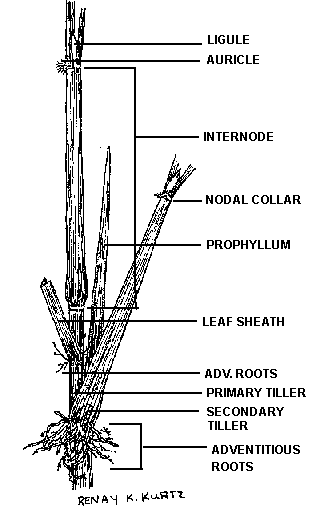- THE BASIC EXTERNAL ANATOMY OF
THE RICE STEM HAS A STRUCTURE SIMILAR TO OTHER MONOCOT GRASSES.
 Another name for the stem of the rice plant is the CULM. The culm consists of several NODES spaced apart by INTERNODES 1 cm apart near the base, and further apart towards the top of the rice plant. The internodal length can reach 10-30 cm at the formation of the panicle from the last internode. At the base of the culm is a bladeless bract called the PROPHYLLUM. At the base we also find ADVENTITIOUS ROOTS that aid the plant in support. The first leaves are generated at the first node. Their SHEATHS envelop the main culm or what is called the PRIMARY TILLER. It is common to see SECONDARY TILLERS that also have leaves with leaf sheaths. Secondary tillers arise from the first node of the primary tiller and generally have a fewer number of leaves. At the leaf junction at the furthermost node,
LIGULES and a pair of AURICLES occur. The panicle also forms at the uppermost
node and gives rise to the spikelets or fruits of the rice plant.
|
|
 |
 |
|
|
|